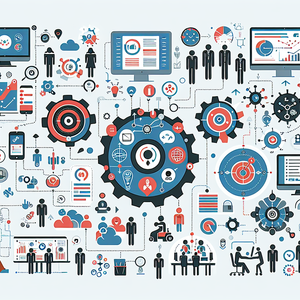The Radiologic Technician in an AI-Driven World

AI has already proven its potential to revolutionize medical imaging. Machine learning algorithms, trained on vast datasets of X-rays, CT scans, MRIs, and other imaging modalities, have demonstrated exceptional accuracy in detecting anomalies. For instance, AI systems can identify early-stage cancers, detect fractures, and evaluate cardiovascular conditions with astonishing efficiency. One notable example is Aidoc, an AI-powered platform that assists radiologists by flagging critical findings in real time. Similarly, Zebra Medical Vision uses AI to identify patterns across millions of images, enabling quicker detection of diseases like osteoporosis, fatty liver, and lung conditions. These tools are not theoretical; they are currently being employed in hospitals worldwide, reducing diagnostic errors and optimizing workflow. However, this progress raises concerns about the role of radiologic technicians. Could the automation of image analysis and diagnosis eventually phase out their need? Such fears overlook the human skills and expertise that machines cannot replicate—qualities that remain central to the work of radiologic technicians.
The Multifaceted Role of the Radiologic Technician
To fully appreciate the future of radiologic technicians in an AI-driven world, it is essential to understand the complexity and breadth of their role. While their primary responsibility is operating imaging equipment, their job extends far beyond pushing buttons. Radiologic technicians serve as the first point of contact for patients undergoing imaging procedures. They help alleviate fears, explain the process, and ensure patients are comfortable during potentially intimidating scans. This human connection is crucial in healthcare, especially for patients with anxiety or pain. Getting a high-quality medical image is not as simple as pressing a button. Radiologic technicians must position patients correctly, adjust imaging settings, and account for variables such as physical limitations or movement. Even the most advanced AI systems cannot ensure the technical quality of an image if the initial capture is inadequate. Radiologic technicians are trained in radiation safety, ensuring that patients receive the lowest dose necessary while achieving diagnostic-quality images. They also troubleshoot equipment issues and ensure that imaging protocols are meticulously followed—tasks that require both technical expertise and situational judgment. Technicians work closely with radiologists to ensure that scans meet diagnostic requirements. They provide context about the patient's condition, scan quality, and any challenges encountered during imaging, offering insights that go beyond what AI algorithms can analyze.
The AI-Technician Partnership
Rather than replacing radiologic technicians, AI is likely to become their most valuable partner. By automating mundane and repetitive tasks, AI can free up technicians to focus on more critical aspects of their work, ultimately enhancing efficiency and patient care. AI tools can analyze images as they are being captured, providing technicians with instant feedback. For example, if a scan is blurry or does not meet diagnostic standards, AI can flag the issue, allowing the technician to make adjustments on the spot. This reduces the need for repeat scans, saving time and minimizing radiation exposure for patients. AI can handle initial image analysis, flagging abnormalities for radiologists and technicians. This allows technicians to prioritize urgent cases and ensures that routine, non-critical scans do not overwhelm healthcare systems. The integration of AI will likely require radiologic technicians to develop new skills, such as understanding AI algorithms, managing data, and troubleshooting AI-driven equipment. This evolution could lead to hybrid roles that combine technical proficiency with advanced analytical capabilities. For instance, technicians might assist radiologists in interpreting AI-generated insights or use AI to identify trends across patient populations. By combining AI’s analytical capabilities with human intuition, the likelihood of diagnostic errors can be significantly reduced. Technicians can act as a second layer of oversight, ensuring that AI-generated findings align with clinical observations and patient histories. This partnership between AI and radiologic technicians has the potential to elevate the field of medical imaging, making it more accurate, efficient, and patient-centered.
The Limits of AI in Radiology
While AI offers tremendous promise, it is not without limitations. Machine learning models depend on the quality and diversity of the data they are trained on, and biases in these datasets can lead to inaccuracies. For instance, an algorithm trained primarily on images from one demographic may struggle to identify conditions in patients from other populations. Moreover, AI lacks contextual understanding. A scan may show an abnormality, but interpreting its significance often requires knowledge of the patient’s medical history, symptoms, and other diagnostic tests. This level of clinical reasoning is something only human healthcare providers, including radiologic technicians, can offer. Finally, healthcare is not just about technology—it is about trust and compassion. Patients are more likely to engage in their care when they feel heard and understood. Radiologic technicians play a key role in building this trust, offering reassurance and empathy during what can be a nerve-wracking experience.
In an AI-driven world, radiologic technicians are not at risk of obsolescence but are poised for transformation. AI has the potential to revolutionize medical imaging, but its success depends on collaboration with human expertise. Radiologic technicians will remain essential not only for their technical skills but also for their ability to connect with patients and ensure the quality and integrity of imaging procedures. As AI continues to advance, the role of radiologic technicians will likely evolve, requiring them to master new technologies while maintaining their focus on patient care. This dynamic partnership between humans and machines promises to deliver the best possible healthcare outcomes, blending the precision of AI with the irreplaceable human touch. Far from being left behind, radiologic technicians are stepping into a new era filled with opportunity and innovation.
AI Integration Specialist for Medical Imaging
GE Healthcare, Siemens Healthineers, Philips, Aidoc, Zebra Medical Vision
Key Responsibilities
Work with healthcare providers to implement AI-powered imaging tools and ensure seamless integration with existing systems.
Train radiologic technicians and staff on the use of AI platforms for real-time image analysis and diagnostic support.
Monitor AI system performance, troubleshoot issues, and collaborate with software developers to enhance algorithms.
Required Skills
Expertise in AI technologies, medical imaging software (e.g., PACS), and machine learning basics.
Strong communication skills to bridge the gap between technical teams and healthcare professionals.
Familiarity with regulatory compliance in healthcare technology (e.g., FDA, HIPAA).
Radiology Workflow Optimization Analyst
Large hospital systems, consulting firms specializing in healthcare optimization, AI healthcare companies
Key Responsibilities
Analyze radiology department workflows and identify bottlenecks or inefficiencies in imaging and diagnostic processes.
Develop AI-driven solutions to streamline workflows, such as prioritizing scans based on urgency or automating routine tasks.
Collaborate with radiologic technicians and radiologists to implement workflow improvements that enhance patient care and reduce turnaround times.
Required Skills
Strong analytical and data management skills; experience with healthcare analytics platforms is a plus.
Familiarity with radiology operations and imaging modalities (e.g., X-ray, CT, MRI).
Ability to translate technical solutions into practical, user-friendly implementations.
Radiology Informatics Specialist
Academic medical centers, imaging centers, large hospital IT departments
Key Responsibilities
Manage and maintain radiology information systems (RIS) and picture archiving and communication systems (PACS).
Ensure interoperability between imaging equipment, AI tools, and electronic health records (EHR).
Support radiologic technicians and radiologists in adopting new technologies, including AI-based diagnostic tools.
Required Skills
Deep knowledge of imaging informatics, including DICOM standards and HL7 interfaces.
Experience with system administration, data security, and troubleshooting imaging software.
Certification in imaging informatics (e.g., CIIP) is often preferred.
Hybrid Radiologic Technician-AI Technician
Hospitals and imaging centers adopting cutting-edge AI tools, such as Mayo Clinic or Cleveland Clinic
Key Responsibilities
Operate traditional imaging equipment (X-ray, CT, MRI) while leveraging AI tools to optimize image quality and enhance diagnostic accuracy.
Interpret AI-generated insights and collaborate with radiologists to ensure findings align with patient histories and clinical observations.
Stay updated on emerging AI technologies and assist in training colleagues on their applications in radiology.
Required Skills
Certification as a radiologic technician (e.g., ARRT) with additional training in AI-driven imaging tools.
Ability to interpret AI-generated reports and troubleshoot imaging-related AI systems.
Strong interpersonal skills for patient interaction and teamwork with radiologists.
Medical Imaging Data Scientist
AI startups like Tempus or PathAI, academic research institutions, major tech companies investing in healthcare (e.g., Google Health, NVIDIA)
Key Responsibilities
Build, train, and refine machine learning models to analyze medical imaging data, improving diagnostic accuracy and efficiency.
Work with radiologists and radiologic technicians to collect and label imaging datasets for AI development.
Research and develop algorithms to identify complex patterns in imaging data (e.g., cancer detection, organ segmentation).
Required Skills
Advanced proficiency in programming languages (e.g., Python, R) and machine learning frameworks (e.g., TensorFlow, PyTorch).
Solid understanding of medical imaging technologies and data formats (e.g., DICOM).
Background in data science, bioinformatics, or a related field, often requiring a master’s or Ph.D.


